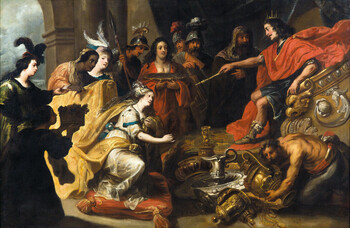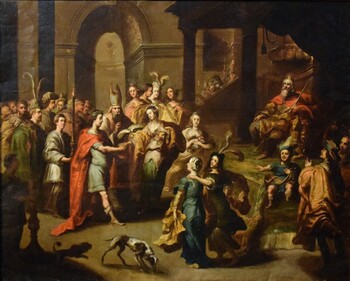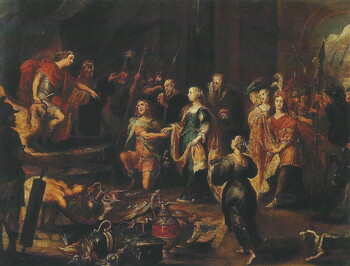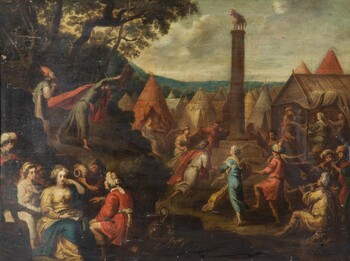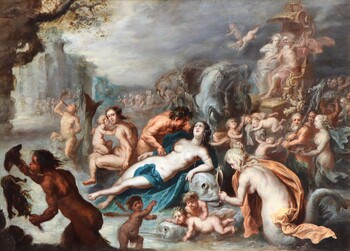4.350 €
Susanna and the Elders
Oil on copper : 40,8 X 54,4 cm
Unsigned
Frame : 57,4 X 71,8 cm
In short
Pauwels Casteels specialised in two very different subjects: battle scenes and biblical-mythological scenes. His paintings on copper plates were popular in Spain, where they were regularly exported to from his birthplace Antwerp.
Here we have a Me Too subject avant-la-lettre: two excited old men intimidating a young woman to make love with them.
About Pauwels Casteels
Flemish painter
Antwerp circa 1625 – in or after 1677
His first name is sometimes spelt Pauwel.
Painter of history scenes (biblical and mythological subjects), battle scenes and of landscapes.
He was the son of a further unknown Antwerp painter. Pauwels joined the Painters’ Guild of Saint Luke in Antwerp in the year 1649/50.
The contemporary Antwerp battle scene painter Alexander Casteels (circa 1635 – 1681) was probably a family member; there are obvious stylistic similarities between both painters.
Casteels is best known for his large canvasses with numerous figures representing heroic battle scenes: either biblical, Greek or Roman subjects or contemporary clashes between Christians and Turks. He was clearly influenced by two earlier Flemish specialists of battle scene paintings : Pieter Snayers (1592 – after 1666) and above all Pieter Meulener (1602 – 1654). Casteels painted several versions of the Polish King John Sobieski III beating the Turks, which he did twice: in 1673 and in 1683 (the last one was the famous Battle of Vienna). There was a large demand for these battle scenes by our painter in Vienna, where the Forchondt art dealers exported them to.
Casteels’s mythological paintings are much rarer, but much more sought after. Most of these were painted on copper plates. For these there was beside the local Flemish market a strong demand from Spain.
Pauwels Casteels provided pictures for one of Antwerp’s best-known international art dealers, Guilliam Forchondt I (1608 – 1678). The company of Forchondt (also known as Forchoudt), himself also a painter, exported a lot of artwork to Central Europe (especially to Vienna) and to a lesser extent to Spain, Nueva Espana (Mexico) and Portugal. Battle scenes by both Pauwels and Alexander Casteels seem to have been popular in Central and Eastern Europe.
The export paintings to Spain were often painted on copper plates.
About the subject of our painting
Our painting represents an attractive biblical story from the Ancient Testament, from the Book of Daniel. Attractive also within the society of those days, which was already very dual: religious, but also interested in a female nude. Therefore women bathing, be it religious subjects, such as Bathsheba or Susanna, or mythological themes, such as Diana, were very popular.
Our story is set during the so-called Babylonian Exile. One hot day Susanna, the beautiful and pious wife of Joachim, took a refreshing bath in her walled garden. She was alone, as she had sent away her servants.
Two lustful old men spied on her. They threatened to accuse her falsely of having seen her made love with a young man, if she would not agree to satisfy their needs.
Susanna refused and she was to be stoned to death. Already on the way to the execution field the Prophet Daniel separated both men; on his question under what sort of tree the adultery allegedly took place, he got two completely different answers.
Susanna’s innocence is proved and she is set free. The two horny accusers, they were actually judges, were executed.
About paintings on copper
Seventeenth and eighteenth century Flemish (and Dutch) artists painted on oak panels, on canvas and on copper. Copper was the most expensive, but also the best support. Wooden panels can suffer from sudden changes in the degree of humidity, canvasses can be torn, while copper plates are less vulnerable.
Because of their even, highly rigid and non-absorbent surface, coppers did not need a preparatory layer (sometimes only a very thin ground) and one can paint extremely precisely, the paint could be applied almost without any visible brushstrokes. In old recipes it was advised to rub the copper plate with garlic, so that the oil paint would adhere better.
As copper was more expensive and as one could paint in a very detailed way on them, most copper plates are therefore of rather small dimensions. Artists painted on copper delicate, elaborate and highly finished paintings with brilliant pictorial effects, carefully rendering the details of physiognomy and of dress. Another advantage of these copper plates today is the fact that they have very little craquelure.
Why should you this painting?
Because it is a very decorative scene painted on a copper plate.
Comparative paintings
Click photos for more details

